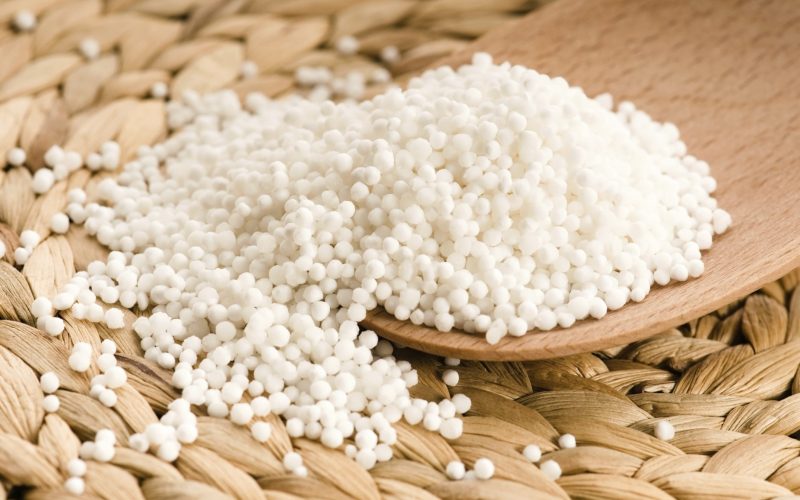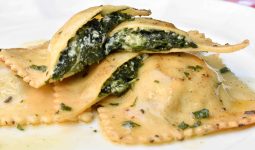Tapioca can be an essential part of so many dishes, whether you use it to thicken up your fruit cobbler or as the binder in your salmon patties.
But have you ever been caught out and had to make something that called for quick cooking tapioca when you didn’t have any? Don’t panic! We made you a list of substitutes for quick cooking tapioca.
There are plenty of great substitutes for quick cooking tapioca that can help save your dish from being ruined!
Here are some great options to give your dish the texture it needs without resorting to a last-minute trip to the store for some quick cooking tapioca!
What Is Tapioca Starch?
Tapioca Starch is a white powder made from the root of the cassava plant. Tapioca starch is gluten-free and often used to create dishes with a lighter, fluffier texture.
Furthermore, tapioca has no flavor and can be used in sweet or savory dishes. Tapioca Starch can be found in the baking aisle of most grocery stores, near other thickening agents like cornstarch or flour.
Equally important, there are many substitutes for quick cooking tapioca.
What is Tapioca Starch Used for?
Tapioca starch is a gluten-free, Paleo-friendly ingredient and is great as a thickener. Tapioca starch is also used in some Asian recipes, such as boba tea.
While it can be hard to find in grocery stores, you can buy it online or at an Asian market. However, there are also great substitutes for quick cooking tapioca.
Moving on, tapioca starch comes from the cassava root and is also known by its scientific name Manihot esculenta.
Tapioca starch is often used in baking sweets like pie crusts and cookies because of its stability at high temperatures.
You can use it to make a pudding without eggs by boiling milk with tapioca starch until it becomes clear. Then, stir in cornstarch dissolved in cold water.
Tapioca Starch vs. Tapioca Flour
Tapioca starch and tapioca flour are often used interchangeably, but they’re actually two different things. Tapioca starch is made from cassava root.
Tapioca flour comes from the same plant, but the product grinds the root’s dried roots into a fine powder.
So while they’re both derived from the cassava root, they are two different products with different recipe applications.
The most important difference is that tapioca starch can be used as a thickening agent in sauces or soups.
Also, it helps prevent food from sticking to pans when frying or searing meat or vegetables because it’s naturally gluten-free and non-sticky, like cornstarch.
There are a few differences between tapioca starch and tapioca flour, but they can both be used as substitutes for quick cooking tapioca in many dishes.
One of the main differences is how much they thicken. Tapioca starch will create a thicker sauce, while the flour will produce a thinner one.
Moreover, they also have different textures and flavors, with the starch being more grainy and hard to dissolve than the flour, which dissolves easier.
The difference in texture creates different results as well. You should use the starch for a smoother consistency when substituting it for pudding or custard.
If substituting for pie filling or fruit topping, use the flour to avoid adding too much thickness to the recipe.
Substitutes for Quick Cooking Tapioca
1. Arrowroot
Arrowroot is one of the best substitutes for quick cooking tapioca because it’s a grain-free and gluten-free option.
It will thicken your dish and have a neutral flavor so that you can use it in any recipe. Arrowroot contains more protein than tapioca and is an excellent calcium, magnesium, potassium, and iron source.
Going further, you can find arrowroot at most grocery stores or online. Arrowroot powder is another option you can try, as it’s clear and flavorless but more expensive than cornstarch.
Whichever you choose, make sure to stir the mixture well with cold water or milk before incorporating it into the recipe so that it doesn’t clump up too much.
Arrowroot is most often used as an alternative to white rice in Asian dishes. This is because of its ability to absorb flavors well, but it also works well as an instant starch replacement if mixed with cold liquids first (similarly to all-purpose flour)
2. Potato Starch
The second on this list of substitutes for quick cooking tapioca is potato starch. It can be used as an alternative to quick-cooking tapioca. It has the same consistency and is a good substitute when making custards and pies.
Potato starch is also a great substitute if you’re gluten-free because it’s one of the best gluten-free ingredients.
Cornstarch works well in place of quick-cooking tapioca too. Just add it to the recipe along with one-third more potato starch than what is called for in the recipe.
Moreover, potato starch does not have much flavor, so it’s a good choice when you want to keep other flavors from being masked by their taste.
Cornstarch is another common substitute for instant tapioca in small quantities. The difference between cornstarch and flour is that cornstarch needs to be mixed with something acidic (such as lemon juice) before being added to a hot mixture. This helps create a more stable thickener.
3. Cornstarch
Cornstarch is one of the common substitutes for quick cooking tapioca, as it doesn’t need to be cooked before adding to recipes.
Use cornstarch or arrowroot powder in place of instant tapioca. Cornstarch can also be used as a thickener in sauces and gravies.
Further, cornstarch withstands the test of time and will not break down when boiled. Plus, you can easily find it at any supermarket! Try substituting with cornstarch next time you make rice pudding; the taste won’t disappoint!
4. Rice Flour
Talking about great substitutes for quick cooking tapioca, rice flour is one. It’s a good thickener and doesn’t need as much liquid added to it as some of the other substitutions on this list.
However, the downside is that rice flour can have a slightly different texture than what you might be looking for in the final product.
If you’re using rice flour, make sure to add a little bit more water to compensate. If you’re unsure how much, start with 1/4 cup of water and go from there!
5. All-purpose Flour
For dishes like scrambled eggs, crepes, and some pasta sauces, all-purpose flour can be one of the best substitutes for quick cooking tapioca in small quantities.
If you’re using flour to thicken a sauce or soup, mix it with some cold water first before adding it to the hot liquid.
This will help prevent lumps from forming and provide a smoother texture. Coupled with that, it will add a nutty flavor to your end result.
6. Mochiko
Mochiko is a type of rice flour that can be used to make dumplings, noodles, and other Asian dishes. You can find it in your local grocery store’s baking or international food aisle.
It’s also sometimes called mochi flour or sweet rice flour. If you don’t have any on hand, try substituting cornstarch, arrowroot powder, semolina, or even instant mashed potatoes as an alternative. This is equally one of the best substitutes for quick cooking tapioca!
7. Heavy Cream
Looking for substitutes for quick cooking tapioca? You can use heavy cream as a substitute for tapioca in any recipe. The ratio of 1 tablespoon of cornstarch to one cup of heavy cream.
Make sure you mix the starch with a little water and bring it to a boil before adding the boiling liquid to whatever you’re making.
When using heavy cream, as in pasta sauces or creamy soups, any other thickening agent, such as flour or roux, can be used.
But if you are only substituting heavy cream for tapioca in sweetened puddings, then do not add any other thickeners, such as flour or cornstarch, because they will create an unpleasant taste.
In order to get a smooth consistency, ensure the sauce is at room temperature before stirring in the starch mixture.
Be careful not to let it boil after this point because too much heat will weaken the thickener’s effectiveness.
8. Collagen or Eggs
If you’re in a pinch, eggs are great substitutes for quick cooking tapioca! Just whisk the eggs with water and add the mixture to your pot. The egg will thicken up as it boils.
Remember, don’t bring the mixture to a boil before adding it, or you’ll end up with scrambled eggs instead of pudding-like tapioca. This is a creative way to thicken recipes, especially for sweet things.
9. Cassava Flour
Tapioca is a versatile ingredient that can be used in many recipes. It’s made from cassava root and is known to cook more quickly than other starches, such as cornstarch or arrowroot powder.
However, it may not be easy to find tapioca pearls in stores because they’re becoming less popular. Also, store shelves are being filled with other options, such as potato starch, rice flour, and cornstarch.
If you want to use tapioca, some substitutes for quick cooking tapioca have been made available for those who can’t find it. One of them is cassava flour.
This option is gluten-free and becomes light and fluffy when cooked. Cassava flour is a great alternative that is gluten-free, with a slightly nutty flavor too.
10. Pectin and Gelatin
Of the substitutes for quick cooking tapioca, this starch is often used to solidify jams and jellies and thicken sauces.
Cornstarch, arrowroot powder, or a mix of cornstarch and arrowroot powder are good substitutes for pectin in a pinch.
Further, two tablespoons of cornstarch or arrowroot powder can be substituted for one envelope of dry pectin in any recipe requiring liquid or dry pectin.
However, the resulting gel may not be as firm as it would be with regular commercial-grade pectin. To improve your gel’s setting properties, add 2 tablespoons of water per tablespoon of cornstarch or arrowroot powder used.
11. Agar Agar
The last of this list of the best substitutes for quick cooking tapioca is Agar agar, the vegan version of gelatin made from red algae.
It’s flavorless and colorless and provides a good texture in puddings, marshmallows, and jellies. Agar agar is also used as a thickener or setting agent in desserts such as mousse or custard.
Substitute 1/4 teaspoon agar powder mixed with 1 tablespoon water for each packet of unflavored gelatin called for in the recipe.
This gelatinous substance is derived from seaweed and will create a thickening agent like tapioca does. This winds up our list of substitutes for quick cooking tapioca!
Conclusion
There’s nothing worse than realizing you don’t have the right ingredients to complete your favorite recipe at the moment. Plenty of recipes call for quick cooking tapioca, but what do you do if you don’t have any on hand?
Don’t panic! This list includes the best substitutes for quick cooking tapioca that will save your dish. So it’s best to keep substitutes on hand in case of an emergency.








